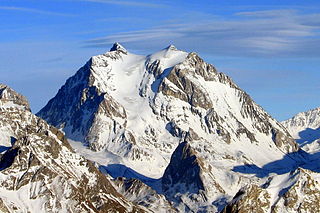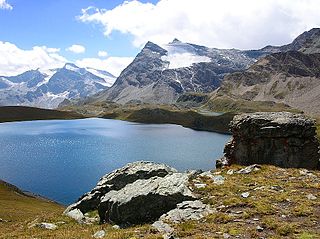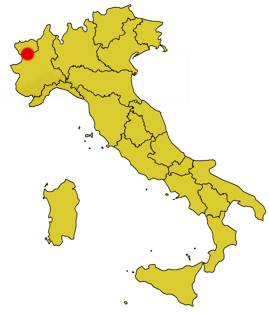
The Pennine Alps French: Alpes Pennines, German: Walliser Alpen, Italian: Alpi Pennine, Latin: Alpes Poeninae), sometimes referred to as the Valais Alps, are a mountain range in the western part of the Alps. They are located in Italy and Switzerland (Valais).

The Graian Alps are a mountain range in the western part of the Alps.

The Gran Paradiso or Grand Paradis is a mountain in the Graian Alps in Italy, located between the Aosta Valley and Piedmont regions. It is located in Gran Paradiso National Park.

The Alpine ibex, which is also known as the steinbock, is a species of goat that lives in the Alps of Europe. It is one of ten species in the genus Capra and its closest living relative is the Iberian ibex. The Alpine ibex is a sexually dimorphic species; males are larger and carry longer horns than females. Its coat is brownish-grey. Alpine ibexes tend to live in steep, rough terrain and open alpine meadows. They can be found at elevations as high as 3,300 m (10,800 ft) and their sharp hooves allow them to scale their mountainous habitat.

Maurienne is one of the provinces of Savoy, corresponding to the arrondissement of Saint-Jean-de-Maurienne in France. It is also the original name of the capital of the province, now Saint-Jean-de-Maurienne.

Vanoise National Park is a French national park between the Tarentaise and Maurienne valleys in the French Alps, containing the Vanoise massif. It was created in 1963 as the first national park in France.

Herbétet is a mountain in the Gran Paradiso massif, a sub-group of the Graian Alps, with an elevation of 3,778 metres (12,395 ft). It is located between the Cogne Valley and the Valsavarenche Valley.

The Nivolet Pass is a mountain pass in the Eastern group of the Graian Alps in northern Italy. It is located at the top of the Orco Valley on the road from Turin to Ceresole Reale, in the Gran Paradiso National Park. Beyond the pass, the road terminates in the upper reaches of the eponymous Valsavarenche valley in the Gran Paradiso mountain group, before the valley descends to Valsavarenche and Villeneuve. The colle forms part of the boundary between the Aosta Valley and the Piedmont region. The highest point of the paved road is 2,641 metres. Two artificial lakes, Serrù Lake and Agnel Lake, are located immediately below the pass.

The Orco Valley is a valley in the Piedmont region of northern Italy located in the Graian Alps, in the territory of the Metropolitan City of Turin. The valley takes its name from the Orco river, which flows through the valley.

The Chiusella valley is a valley in the Province of Turin.

The Dolomiti Bellunesi National Park is a national park in the province of Belluno, Veneto, in the northern Italy.

The Mont Tout Blanc is a 3,438.2 metres high mountain belonging to the Italian side of Graian Alps.

The Punta Leynir is a 3,238 metres high mountain belonging to the Italian side of Graian Alps.

The Punta Bes is a 3,177 metres high mountain belonging to the Italian side of Graian Alps.

The Alps conifer and mixed forests is a temperate broadleaf and mixed forests ecoregion in central Europe. It extends along the Alps mountains through portions of France, Italy, Switzerland, Germany, Liechtenstein, Austria, and Slovenia. The ecoregion extends from the lower slopes of the Alps to its peaks, which include Mont Blanc, at 4,809 m (15,778 ft) the highest peak in the Alps.

The Roc is a mountain of the Gran Paradiso massif, in the Graian Alps in Italy. It is located between the Aosta Valley and Piedmont regions and is the highest point in the Metropolitan City of Turin.

The Maritime Alps Natural Park is a nature reserve in Piedmont, Italy. Originally established in 1980 as the Argentera Natural Park, in an area previously part of a royal hunting reserve established by Victor Emmanuel II in 1857, it assumed its current name and form in 1995, when it was merged with the Palanfrè Woods and Lakes Natural Reserve. Located near the border with France, the park borders the Mercantour National Park.

The Orsiera-Rocciavrè Natural Park is a nature reserve in Piedmont, Italy. Established in 1980, it covers a vast Alpine area between the Val Susa and the Val Chisone, in the Graian Alps and the Cottian Alps. The Site of Community Importance of Orsiera-Rocciavrè is part of the park, whose highest point is the peak of Monte Orsiera, 2,890 meters above sea level. The Colle delle Finestre, the Fenestrelle Fort and the Montebenedetto Charterhouse are also located inside the park.

The Gran Bosco di Salbertrand Natural Park is a nature reserve in Piedmont, Italy. Established in 1980, it protects the Site of Community Importance of the Great Woods of Salbertrand, in the Val Susa, south of the Dora Riparia, between 1,000 and 2,700 meters above sea level. The woods, which cover an area of about eight hundred acres, consist of a mix of silver firs and Norway spruces, rarely found in the Western Alps.

The Ampezzo Dolomites Natural Park is a nature reserve in Veneto, Italy. Established in 1990, it is entirely located in the territory of Cortina d’Ampezzo, in the Province of Belluno, and encompasses some of the most famous Dolomitic groups, such as the Tofane, Monte Cristallo, the Croda Rossa d'Ampezzo, Lagazuoi, Pomagagnon and Col Bechei. Together with the adjacent Naturpark Fanes-Sennes-Prags in the Province of Bolzano, it forms a protected area of 37,000 hectares in the heart of the Dolomites. The park has been designated as a Site of Community Importance, and about one quarter of its territory is afforded further protection through twenty smaller reserves.



























